What is the Royal Mews?
The Royal Mews is a department of the Queen’s household and is responsible for all travel by road undertaken by the Queen and her family. It houses the Queen’s carriages and carriage horses as well as a fleet of cars.
 |
| Diamond Jubilee State Coach at Royal Mews, Buckingham Palace (2017) |
The history of the Royal Mews
The King’s Mews goes back to the 14th century when Richard II was on the throne, and was originally at Charing Cross, where the National Gallery is now. It was the place where the king kept his falcons and the name mews comes from the falcons mewing, that is, moulting. Henry VIII rebuilt the mews as stables in 1534 but kept the name ‘mews’ and it has been associated with horses ever since.
 |
| The quadrangle of the Royal Mews, Buckingham Palace (2017) |
In 1761, George III bought Buckingham House for his wife, Queen Charlotte. He commissioned the building of the Riding School, which is the oldest part of the Mews. It was designed by the architect Sir William Chambers and built in 1765-6.
After George IV succeeded to the throne in 1820, he decided to rebuild Buckingham House and make it his royal palace. The Royal Mews was built in 1822-5 and was designed by the architect of Buckingham Palace, John Nash. Unfortunately, the foundations were faulty, there was a drainage problem, and the original building work was shoddy so that it was constantly under repair.
Nash built the Doric-style arch topped with a clock tower leading into the quadrangle of the Mews, but the pediment carving portraying the tale of Hercules catching Thracian horses was added later, in 1859.
The Master of the Horse
Traditionally, the Royal Mews was under the control of the Master of the Horse – a very senior position in the royal household. The Master of the Horse is no longer a hands-on role, and the Royal Mews is now run by the Crown Equerry.
The Riding School
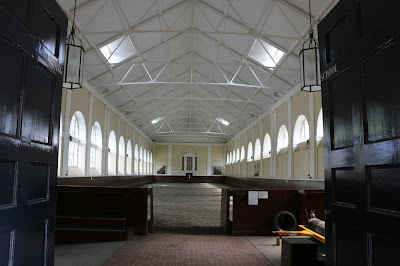 |
| The Riding School at the Royal Mews, Buckingham Palace (2017) |
 |
| Semi-state Landau at the Royal Mews, Buckingham Palace (2017) |
Built in 1830 for the Duke of Cambridge, it was used by his family before being sold to the 9th Earl of Albermarle. The earl converted it into a semi-state landau before giving it to Queen Mary in 1920.
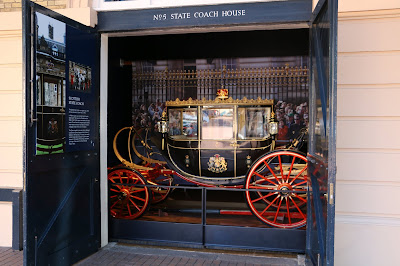 |
| Scottish State Coach at the Royal Mews, Buckingham Palace (2017) |
Used to take the crown to the Houses of Parliament for the state opening of parliament.
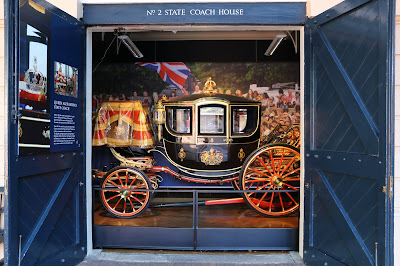 |
| Queen Alexandra's Coach at the Royal Mews, Buckingham Palace (2017) |
Originally built in Dublin in 1803-4, the Irish State Coach was bought by Queen Victoria after seeing it at an exhibition in 1852.
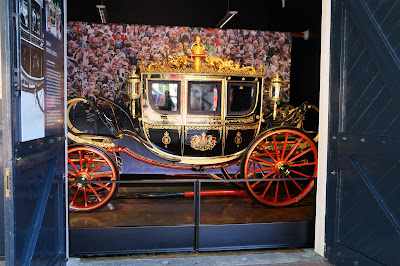 |
| Irish State Coach at the Royal Mews, Buckingham Palace (2017) |
A gift to the Queen from the people of Australia, this coach is normally on display in the Royal Mews, but is currently part of the 2017 exhibition at Buckingham Palace, Royal Gifts, until 1 October.
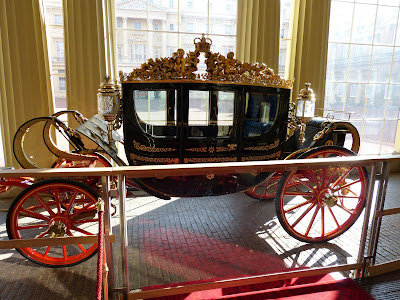 |
| Australian State Coach on display at Buckingham Palace in 2015 |
Used by many royal brides to travel to their weddings including Lady Diana Spencer in 1981.
 |
| Glass Coach at the Royal Mews, Buckingham Palace (2017) |
 |
| Glass Coach at the Royal Mews, Buckingham Palace (2017) |
This coach is a travelling time capsule. It is full of historical artefacts including a hollow crown on its roof made from wood from HMS Victory and a digital copy of the Domesday book.
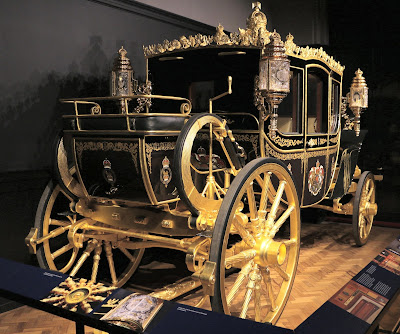 |
| Diamond Jubilee State Coach at Royal Mews, Buckingham Palace (2017) |
The Gold State Coach is on display in the former State Carriage House. It was commissioned by George III, and was first used by the king to travel to the House of Lords to open parliament on 25 November 1762. Despite appearances, the coach is not made of gold, but is gilded all over, with external panels painted by Giovanni Battista Cipriani.
The coach has been used for every coronation since that of George IV in 1821. There is a frieze around the walls showing William IV’s coronation procession in 1831, painted by Richard Barrett Davis (1782-1854).
 |
| Gold State Coach at the Royal Mews, Buckingham Palace (2017) |
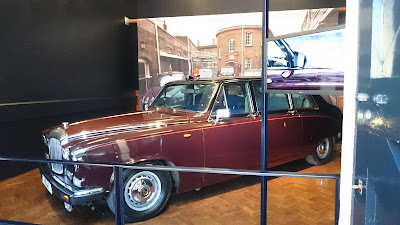 |
| Royal car at the Royal Mews, Buckingham Palace (2017) |
The State Stables have a replica landau that visitors may sit in to get an idea of the suspension (or lack of it) in a royal carriage. There are also opportunities here to dress up as a footman and learn how to harness a horse.
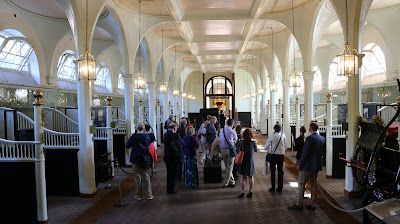 |
| The State Stables at Royal Mews, Buckingham Palace (2017) |
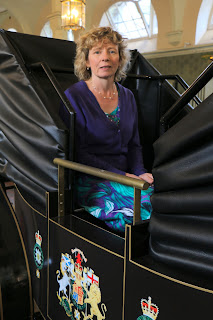 |
| Rachel in the replica landau in the State Stables, Royal Mews, Buckingham Palace (2017) |
The stables house the Queen’s carriage horses including the Queen’s famous Windsor Greys and Cleveland Bays.
 |
| The stables at the Royal Mews, Buckingham Palace (2017) |
 |
| The harness room at the Royal Mews, Buckingham Palace (2017) |
Rachel Knowles writes clean/Christian Regency era romance and historical non-fiction. She has been sharing her research on this blog since 2011. Rachel lives in the beautiful Georgian seaside town of Weymouth, Dorset, on the south coast of England, with her husband, Andrew.
Find out more about Rachel's books and sign up for her newsletter here.If you have enjoyed this blog and want to encourage me and help me to keep making my research freely available, please buy me a virtual cup of coffee by clicking the button below.
Last visited for bloggers' breakfast on 1 August 2017
All photographs © Regencyhistory.net



I found the bloggers breakfast/Press day fascinating - but am really embarrassed that I didn't know you were there!
ReplyDeleteMike
What a shame - I didn't realise you were there either. It would have been good to have finally met! I didn't advertise that I was going as we had a last minute change in plans and were suddenly able to go. Next time...
Delete